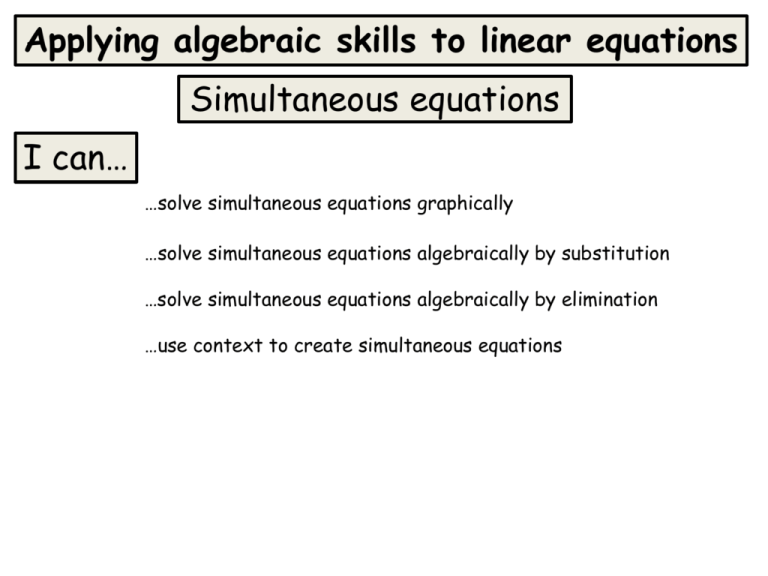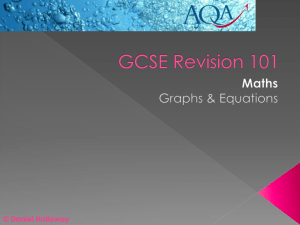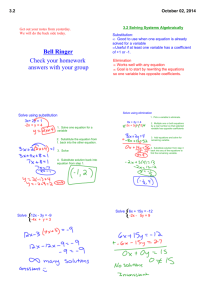Simultaneous equations
advertisement

Applying algebraic skills to linear equations Simultaneous equations I can… …solve simultaneous equations graphically …solve simultaneous equations algebraically by substitution …solve simultaneous equations algebraically by elimination …use context to create simultaneous equations An introduction Reminders The equation y = mx + c can be represented by a straight line which has a gradient of m and passes through the point (0, c) Systems of Equations A System of Equations consists of two (or more) equations with at least two variables. These are also referred to as Simultaneous Equations as their solution holds true for both equations. When the System consist of two equations, with two variables, there are three methods of finding the solution: * by drawing graphs * by substitution * by elimination …solve simultaneous equations graphically If the lines representing the equations are drawn then the solution is the coordinates of the point where the lines intersect (meet). Drawing straight lines Either: - set x = 0, find the y-coordinate from the formula, then set y = 0 and find x - pick 2 values for x and find the corresponding values of y - use the y-intercept, gradient and y = mx + c Example 2– 2 4 6 8 Solve these equations simultaneously 2– 2 4 6 8 Line two - y = 7 – x y = ½x + 1 & y = 7 – x intercept = (0, 7) Line one - y = ½x + 1 When x = 0, y = When x = 2, y = ½×0+1 = 1 → (0, 1) ½×2+1 = 2 → (2, 2) y m= -1 8 6 4 Draw the two lines with the given information Lines intersect at (4, 3) so solution is x = y= 2 4 3 –2 –2 2 4 6 8 x …solve simultaneous equations graphically Simultaneous equations are often used to solve problems and use letters other than x & y. Solving simultaneous equations graphically will often only give approximate solutions and relies on accurate drawing of graphs. In order to get precise solutions it is better to use one of the other methods – substitution or elimination. (continued) …solve simultaneous equations algebraically by substitution At the point where the lines meet, the values of x and y are the same in both equations. This allows the first equation to be substituted into the second. Examples 1) y = x + 1 y = 4x – 5 x+1 = 4x – 5 Make x the subject of the formula 1 = 3x – 5 6 = 3x x = 2 x = 2, y = 2 + 1 = 3 the solution is 3 = 4×2–5 Replace the y in the second equation with the first (2, 3) Substitute x into the first equation to find y Check by substituting into the second equation, if it is true the solution is correct 2) y = 4x + 1 2y – 5x + 4 = 0 2 (4x + 1) – 5x + 4 = 0 8x + 2 – 5x + 4 = 0 3x + 6 = 0 3x = –6 x = –2 x = -2, y = 4 × (–2) + 1 = – 7 the solution is (–2, –7) 2 x (-7) - 5 x (-2) + 4 = 0 …solve simultaneous equations algebraically by substitution Sometimes it is necessary to rearrange one of the equations first. Example 3) y – 2x = 3 3y – 2x = 17 y = 3 Rearrange the first equation 2x + 3 (2x + 3) – 2x = 17 6x + 9 – 2x = 17 4x + 9 = 17 4x = 8 x = 2 x = 2, y – 2 × 2 = 3 y–4 = 3 y = 7 the solution is (2, 7) 3 x 7 – 2 x 2 = 17 Replace the y in the second equation with the first Make x the subject of the formula Substitute x into the first equation to find y Check by substituting into the second equation, if it is true the solution is correct …solve simultaneous equations algebraically by elimination In this method the equations are added or subtracted so that one of the variables will be eliminated. Examples Place the letters in the same order Add/subtract to remove a letter 1) 2x + 3y = 35 7x – 3y = 1 2x + 3y + 7x + (-3y) = 9x 35 + 1 = 36 2) 3x + 2y = 7 5x + 2y = 13 3x + 2y – 5x – 2y = –2x 7 - 13 = – 6 So -2x = -6 So 9x = 36 Solve for the remaining letter Substitute into the first equation to find y x = 4 x = 3 2 x 4 + 3y = 35 3y = 27 y = 9 the solution is 3 × 3 + 2y = 7 2y = –2 y = –1 (4, 9) the solution is (3, –1) …solve simultaneous equations algebraically by elimination Sometimes it is necessary to multiply one or both of the equations before adding or subtracting. Examples Place the letters in the same order Multiply as required Add/subtract to remove a letter 3) 3x + 4y = 26 6x – y = 7 4) 6x + 2y = 38 2x – 3y = 20 4(6x – y) = 4 x 7 3(2x – 3y) = 3 x 20 24x – 4y = 28 6x – 9y = 60 3x + 4y + 24x + (-4y) = 27x 26 + 28 = 54 6x + 2y - 6x – (-9y) = 2y + 9y = 11y 38 – 60 = -22 So 27x = 54 So 11y = -22 Solve for the remaining letter x= 2 y = -2 Substitute into the first equation to find y 3 x 2 + 4y = 26 6x + 2 × (–2) = 38 4y = 20 y = 5 6x = 42 x = 7 the solution is (7, –2) the solution is (2, 5) …solve simultaneous equations algebraically by elimination Example Place the letters in the same order Multiply as required 5) 3x + 2y = 7 4x + 3y = 9 3(3x + 2y) = 3 x 7 9x + 6y = 21 Add/subtract to remove a letter 9x + 6y - 8x – 6y = x 21 – 18 = 3 So x = 3 Substitute into the first equation to find y 3 × 3 + 2y = 7 2y = –2 y = –1 the solution is (3, –1) 2(4x + 3y) = 2 x 9 8x + 6y = 18 …use context to create simultaneous equations Examples 1) A jug and two glasses hold 1·6 litres altogether. Two jugs and three glasses hold 2·9 litres altogether. How much does each hold? Choose appropriate letters j + 2g = 1·6 2j + 3g = 2·9 Multiply as required 2(j + 2g) = 2 x 1.6 2j + 4g = 3·2 Add/subtract to remove a letter Substitute into the first equation to find y 2j + 4g – 2j – 3g = g 3.2 – 2.9 = 0·3 So g = 0.3 j + 2 × 0·3 = 1·6 j + 0.6 = 1.6 j=1 So a Jug holds 1 litre and a glass holds 0·3 litres Some problems can be solved using simultaneous equations by turning the problem into a set of equations. If answering a question set in a particular context you must write your final answer in context. Applying algebraic skills to linear equations Simultaneous equations I can… …solve simultaneous equations graphically …solve simultaneous equations algebraically by substitution …solve simultaneous equations algebraically by elimination …use context to create simultaneous equations An introduction Reminders The equation can be represented by a straight line which has a of m and passes through the point Systems of Equations A System of Equations consists of two (or more) equations with at least two variables. These are also referred to as as their solution holds true for both equations. When the System consist of two equations, with two variables, there are three methods of finding the solution: * by drawing graphs * by substitution * by elimination …solve simultaneous equations graphically If the lines representing the equations are drawn then the solution is the coordinates of the point where the lines intersect (meet). Drawing straight lines Either: - set x = 0, find the y-coordinate from the formula, then set y = 0 and find x - pick 2 values for x and find the corresponding values of y - use the y-intercept, gradient and y = mx + c Example 2– 2 4 6 8 Solve these equations simultaneously 2– 2 4 6 8 Line two - y = 7 – x y = ½x + 1 & y = 7 – x intercept = Line one - y = ½x + 1 When x = 0, y = → (0, 1) y m= 8 When x = 2, y = → (2, 2) 6 4 Draw the two lines with the given information Lines intersect at so solution is x = y= 2 –2 –2 2 4 6 8 x …solve simultaneous equations graphically Simultaneous equations are often used to solve problems and use letters other than x & y. Solving simultaneous equations graphically will often only give approximate solutions and relies on accurate drawing of graphs. In order to get precise solutions it is better to use one of the other methods – substitution or elimination. (continued) …solve simultaneous equations algebraically by substitution At the point where the lines meet, the values of x and y are in both equations. This allows the first equation to be substituted into the second. Examples 1) y = x + 1 y = 4x – 5 = 4x – 5 Replace the y in the second equation with the first 2) y = 4x + 1 2y – 5x + 4 = 0 2 – 5x + 4 = 0 Make x the subject of the formula x = 2, y = the solution is Substitute x into the first equation to find y Check by substituting into the second equation, if it is true the solution is correct x = -2, y = the solution is …solve simultaneous equations algebraically by substitution Sometimes it is necessary to rearrange one of the equations first. Example 3) y – 2x = 3 3y – 2x = 17 Rearrange the first equation y = 3 – 2x = 17 Replace the y in the second equation with the first Make x the subject of the formula x = 2, Substitute x into the first equation to find y the solution is Check by substituting into the second equation, if it is true the solution is correct …solve simultaneous equations algebraically by elimination In this method the equations are added or subtracted so that one of the variables will be eliminated. Examples Place the letters in the same order 1) 2x + 3y = 35 7x – 3y = 1 2) 3x + 2y = 7 5x + 2y = 13 Add/subtract to remove a letter Solve for the remaining letter Substitute into the first equation to find y 2 + 3y = 35 the solution is 3 + 2y = 7 the solution is …solve simultaneous equations algebraically by elimination Sometimes it is necessary to multiply one or both of the equations before adding or subtracting. Examples Place the letters in the same order Multiply as required 3) 3x + 4y = 26 6x – y = 7 4(6x – y) = 4 x 7 4) 6x + 2y = 38 2x – 3y = 20 3(2x – 3y) = 3 x 20 Add/subtract to remove a letter Solve for the remaining letter Substitute into the first equation to find y 3 + 4y = 26 the solution is 6x + 2 the solution is = 38 …solve simultaneous equations algebraically by elimination Example Place the letters in the same order Multiply as required 5) 3x + 2y = 7 4x + 3y = 9 3(3x + 2y) = 3 x 7 Add/subtract to remove a letter Substitute into the first equation to find y 3 + 2y = 7 the solution is 2(4x + 3y) = 2 x 9 …use context to create simultaneous equations Examples 1) A jug and two glasses hold 1·6 litres altogether. Two jugs and three glasses hold 2·9 litres altogether. How much does each hold? Choose appropriate letters Multiply as required 2(j + 2g) = 2 x 1.6 If answering a question set in a particular context you must write your final answer in context. Add/subtract to remove a letter Substitute into the first equation to find y Some problems can be solved using simultaneous equations by turning the problem into a set of equations. j+2× = 1·6 So a Jug holds 1 litre and a glass holds 0·3 litres




